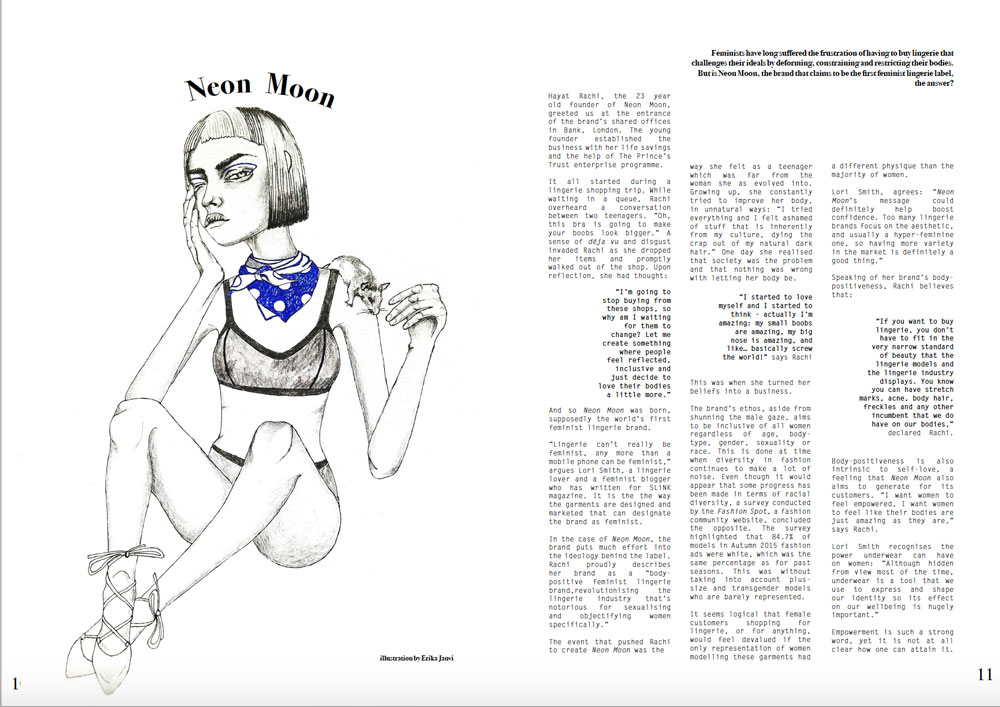The LCFBA16 Class of 2016 series turns to this year’s BA (Hons) Fashion Journalism students, who study a variety of journalistic techniques including research, Teeline shorthand, visual communication and media law, as well as using the tools to deliver stories via a variety of mediums.
We spoke to Jessica Leclerq and Ryan Vincent to find out about their time at LCF, what they enjoyed most about their course and what advice they would give to future fashion journalism students.

Jessica Leclerq’s Antigone Cover. Illustration: Katy Jalili.
Tell us an interesting fact about yourself…
Jessica: I’m very superstitious – I knock on wood at least every hour!
Ryan: I once danced on stage with Katy Perry.
Talk us through your final project:
Jessica: My final project, Antigone magazine, embraces womanhood and the under-represented. Race, size, sexuality, disability and gender are always depicted in a uniformed way throughout the fashion industry. Antigone celebrates the fact that beauty is in individuality and diversity.
Growing up, I felt pressurised to look a certain way – everywhere I looked I saw perfect faced, tall, white, skinny models, in fashion magazines or in advertisements. Diversity is a hot topic in fashion with more and more brands trying to be more inclusive, but the statistics still remain dreadful. I wanted to make a change – I wanted women to feel intelligent, confident and to learn something.

Photographer: Shingi Rice, Models: Jinan Petra and Sai @BridgeModels, MUA: Chloe Downton, Stylist: Anna Kim and Creative Director: Jessica Leclercq
Ryan: My project, Tactile, is a multimedia publication investigating the intersection of fashion, technology and science. The bulk of the content gravitates around textile innovation but there’s a fair amount of focus on how technology is influencing other facets of these industries as well: retail, customer experiences and manufacturing.
What techniques or theories did you use to create your final piece of work?
Jessica: FEMINISM!
Ryan: The most challenging part of creating a multimedia publication (print, broadcast and online) was honing all of the technical skills and techniques required to create a viable and believable brand for each of those media. This took a lot of time on Lynda and the absolute destruction of my ⌘Z keys!
Describe your work in five words…
Jessica: Researched, disturbing, visually attractive, woman-friendly, inclusive.
Ryan: Future as fantasy made reality.

By Ryan Vincent
What do you love about what you do?
Jessica: The freedom of it.
Ryan: Exploring emerging fields of work is fascinating. Sometimes I find it difficult to wrap my head around some of the concepts and technologies being used at the fringes of innovation, but that’s what makes it so interesting for me – it’s a chance to explore the unfamiliar and the unknown.
What’s the best thing about LCF and your course?
Jessica: The whole vibe of LCF is amazing – being surrounded by creative, emerging, talented, students. In terms of the course, we’re basically free to do whatever we want with our work, which is great. There’s a great deal of freedom.

Spread from Antigone Magazine. Illustration: Nicole Calow
Ryan: All the colleges at UAL have such a diverse student body that inspiration comes from every direction. It can be intimidating to see such immense creativity from fellow students, and it makes you question yourself and your abilities, but I think this is a good thing because it challenges you creatively.
There’s a lot of freedom on the course, especially in final year. At the end of the day your degree is what you make of it, and the power we are given as individuals to create and execute our brand and our vision is something I’ve never really had before in an academic environment.
Have you undertaken any work experience or done a placement whilst at LCF?
Jessica: I did an internship at Beyond Retro with the help of the LCF Careers team, as well as an internship at Chanel which I secured by myself, during summer holidays. Through my work experience I learned PR and Marketing techniques.
Ryan: For my work placement in second year I worked for Time Out in Chicago – I got this simply by calling them up and asking for a job. In the summer of second year I worked for Ogilvy in Hong Kong, which I got through personal contacts. I’ve also been working as an editorial intern for a small medical technology company through my second and third years. Working in the real world is so much different from a university environment and this has been an invaluable experience. The pace is faster and balancing work and life is something you can’t learn in education unless you’re working simultaneously.
- Still from Ryan Vincent’s film
- Still from Ryan Vincent’s film
What advice would you give to someone wanting to study your course?
Jessica: Don’t do the course just because you enjoy writing and you love fashion – you actually do have to have some knowledge and interest in the industry as a whole, the business side of it as well – it’s a journalism course after all.
Ryan: The best thing about the course is also the worst thing about the course: the freedom it offers means that your success or failure is down to you. My advice would be to take advantage of all of your tutorials and all the resources at UAL. A massive part of my education at UAL has been through the resources a lot of people don’t even know we have free or subsidised access to.
- Find out more about BA (Hons) Fashion Journalism
- Check out Jessica and Ryan on Showtime
- Find out more about other undergraduate courses at LCF
- Find out more about postgraduate courses at LCF
- Find out more about all courses available at LCF
- LCF Open Days and Events
- More LCF News stories
- Course places available on UCAS Extra



